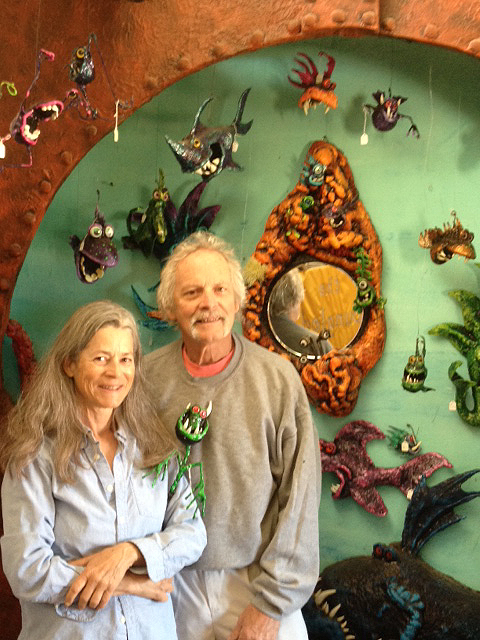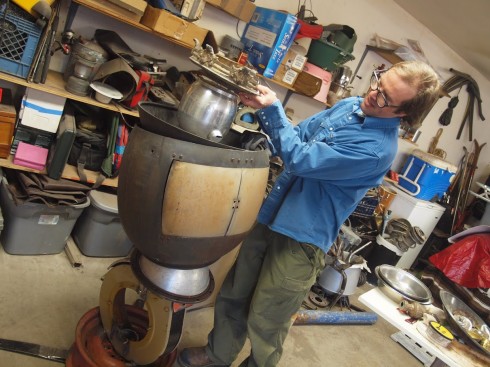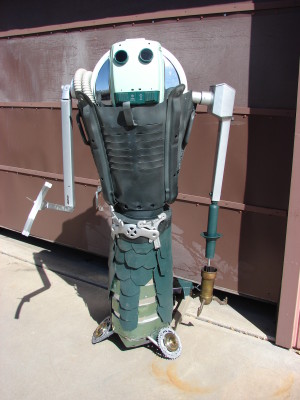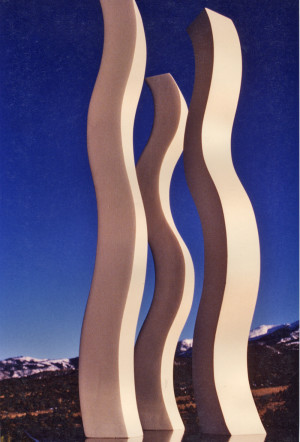By Ericka Kastner
From Pinball Wizard to Severe ReConstructivist
New Orleans-born Rocketman Jimmy Descant has art in his blood. His mother studied fine art at the local community college and sold oil paintings in the French Quarter during the 1950s. His father was a professional photographer who photographed then-Sen. John F. Kennedy in the 1960s and worked as a house photographer for NASA.
The Rocketman’s most recent show, “JFK as an Indian,” on display in Salida last November, looked back at this connection to his roots and combined his own family history with where Jimmy is today, alive and well and severely deconstructing found objects in the Colorado mountain West.
His mother, Pearl, saved his early art (including a drawing that showed the face of a man on the front of piece of paper and on the back, the back of his head) but it was all lost, along with other childhood memorabilia, when Hurricane Katrina hit New Orleans in 2005. Jimmy and his wife Penelope were overwhelmed by the destruction Katrina left behind and chose to salvage what little they could, a pickup truck’s worth of possessions, and move west.

Rock band roadie and vintage pinball machine collector (at one point he had seven pinball machines in his apartment) turned self-taught artist, people told Jimmy he needed to learn from other artists. Instead he spent three or four years creating his own style and coming up with wordplay to explain his work (like his work entitled “Una-Pollack-getic,” saved from Katrina. Studying other artists later, he found overlaps in his own work with that of Pablo Picasso and Marcel Duchamp, and in specific pieces such as Jacob Epstein’s “Rock Drill.”
He says the business of art can drive an artist at times, and he saw this firsthand when he was paying Penelope’s way through nursing school. “I wound up pushing too hard; I ended up getting sick. I had too much intention to be financially successful. It was so lopsided because I was searching for capital.” Since then, Jimmy has intentionally redirected his focus to keep the creativity flowing, and he’s become more particular about the show invitations he accepts.
Severe ReConstructivist is how Jimmy describes what he does, and he says, “If you look it up, you won’t find it.” The sculptures he creates out of raw materials from the golden age of American manufacturing are more commonly referred to as assemblages, because he dismantles objects and then puts them back together (without welding) with an entirely different purpose in mind – sometimes as a rocket, sometimes as a statement on public policy. In addition to sculpture, the Rocketman also performs a number of instant art live performances each year.
“My mom taught me how to garage sale, get bargains, negotiate. If you look at the era of American manufacturing, there is a strength, durability and beauty inside objects created during that time period that people can’t see. I’m glad I grew up in the 20th century, I feel bad for kids growing up now. It’s a sound bite world. When I go in my shop and get my drill press, I make something tangible.”
He’s most proud of one of his rockets now in permanent collection at the Mayo Clinic in Rochester, Minnesota and eight others in “Ripley’s Believe It or Not” museums around the globe.
Locally, Jimmy’s been known at times as the artist who causes a stir, more recently with his display of a work in 2013 (originally intended as guerilla art) entitled “Brains Over Guns” on an abandoned building directly across from the Salida High School. He believes part of his responsibility as an artist is to make statements that are uncomfortable. “I strive for the positive, but I don’t back away from my statement.”
Regarding Salida’s designation as a creative district, Jimmy says as long as the city keeps an eye on growth so the creative minds don’t get pushed out, the designation is a good thing. He fears the town’s funkiness could be disappear if artists can’t afford to stay because of higher taxes.
Artistically, Jimmy wants to be remembered for his personality and his art, but mostly for his intentions. “The word intent is big. From being self-taught to the point of having self-intention is important to me.”
Bunglers and Steampunk Collide

Self-described “bunglers” Pat Landreth and Suzanne Montano say they each bring a healthy dose of mental instability to the creative process behind their sculpted monsters and steampunk art.
“She was considered the unstable one in her family and I’m definitely the unstable one in mine, and that works,” Pat says. “Almost every single creature we do has each of us in it. When we first started, we’d have different perspectives on say, where the eyes should go. It’s nice, with each of us seeing two different things – it adds to the possibilities.”
Bungled Jungle, their gallery at 132 West First Street in Salida, got its name years ago when the duo was headed to an art show. Pat and Suzanne knew their name had to imply their art was flawed to a certain degree, so they first came up with bungled and then added jungle, to refer to the animalistic creatures they were creating.
Their residence just outside Salida, in the sleepy little mountain town of Howard, is the “ultimate thing” they say. Pat and Suzanne initially purchased the cabin because Howard’s real estate values were more cost effective than Salida’s at the time, but they’ve stayed because “all we can see are trees and all we can hear are birds and a trickling stream.”
What many folks don’t know about the pair is that between them, they hold degrees in physics and geology. Pat abandoned pursuing an occupation in physics because he never saw a career that made him say, “Wow. I want to be there.” Suzanne loves to tramp in the woods and hike through mountains, so geology was a natural for her, but Pat says she knew eventually one of her favorite areas would have been mined and it would have broken her heart.
The origin of the monsters can be traced back to Pat’s hands as a small boy where he first began to form the creatures out of soft modeling clay. “My mom used to occasionally steal them away from me and push the clay back into form, but I’d steal it back and make another one … eventually my mom saved a few.”
Pat returned to monsters about 35 years ago. He claims to have a bit of an attention deficit, which he says led him to evolve into a career that allows him to have a short attention span. For a brief time, the physicist received some formal art training but eventually found it depressed him and robbed him of creativity, so he abandoned it.
The technique behind the monsters has been modified a bit over the years into the very sturdy, strong lightweight creatures they are today. Originally inspired by paper mache, each work of art is currently formed from an average of 13 different materials, including six different kinds of plastics, three types of rubber and a variety of metals.
The gallery’s steampunk art grew out of Pat and Suzanne’s fascination with expensive, exotic looking machines. They enjoy “junking” in their spare time and began picking up intriguing parts with the idea of making interesting machines.
“One day someone came into our gallery and said, I see you are making steampunk. I had no idea. Our machines capture moonbeams and recharge fireflies. I don’t know if that’s what steampunk is – I call them silly machines.”
Pat and Suzanne have lived all over Colorado and Montana and say they’ve never experienced ten percent of the support they’ve received from the Salida art community, nor have they witnessed artists making such a significant influence on their community. Originally they didn’t even intend to open a gallery in Salida, and only set up for a one-month, temporary show in 2004. They noticed how much of their business came from passersby, so the “bunglers” never closed their doors. With a laugh, Pat says, “We’re still waiting to have our grand opening.”
Leaving Avocados Behind for Robots

Shelby Cox saved up a pile of scrap metal for four years. It wasn’t until he was faced with loading it into a moving truck when he and his wife Katye, were headed to Oroville, Washington from Silver City, New Mexico, that he decided he’d better do something with it.
The week before the movers arrived, he’d pack boxes all day and spend the evenings tinkering in his garage. On moving day, the robot he’d created was loaded up in the truck, amidst the boxes, and neighbors in Oroville questioned what he was up to when he and Katye arrived in town and set up the robot in their front yard.
That first Halloween in Washington, Shelby filled the inside of the robot with smoke bombs, and the nearest neighbor drove by, cursing at him and shaking her fist. His second robot was created in the driveway of his Washington home, with preschool children watching daily from across the street, wondering what he was welding together.
Before the robots, Shelby earned a master’s in anthropology and a minor in food studies that brought him all the way to Uruapan, Mexico, where he studied organic avocado growers. He left anthropology years later when he had what he calls his Washington epiphany. “We asked ourselves, why are we waiting until we retire to do what we want to do?”
Since their return to Salida two years ago (they lived here before, in 2004), Shelby has created 16 robots, and 12 of them have sold. He has accomplished his goal of displaying a robot in the sculpture garden at the Salida SteamPlant, and his work can be seen around town at The Fritz, Wood’s Distillery and The Hodgepodge.
To say Salida has embraced Shelby’s artwork would be an understatement. Folks from all over town frequently swing by the Robotman’s house at 1141 D St. to drop off parts he could potentially use, unfazed by the presence of Shelby’s original two robots keeping watch in his front yard. There’s also a list on a dry-erase board in his studio of the robots he’s been commissioned to make over the next few months.
Fellow Salida artists Jimmy Descant and painter Jessica Vogel, have traded parts with him, and blacksmith Shark Lambdin has offered welding tips to Shelby, allowing him to add detail to his robots on a small scale.
Ironically enough, Shelby says he’s come across a number of people in Salida who have a master’s in anthropology and a minor in food studies, and who are no longer pursuing either. The connection to anthropology still exists in his art: each of Shelby’s robots has a backstory, and each of the parts used in the creation has a historical record.
People’s interactions with the robots vary. Some people just walk by, he says, while others stop to touch them, even sniff them at times. One of his friends who purchased a robot for her New Mexico home wept when it was delivered, and now she sits beside her “sister robot” in her garden every evening after a stressful day at work. Children love his work, and his three-year-old daughter Ahvy has been lucky enough to have a custom princess robot made just for her.

He has learned to take director Stephen Spielberg’s advice on “killing your babies” when it comes to making his robot creations. It is not uncommon for Shelby to change what he thought would be a head into an entirely different part for the robot before it is finished.
Shelby gets asked what he’s going to do when the robots take over, and he smiles when he tells them, “I’ll start making things to take down the robots.”
With science fiction as his muse, Shelby said films are often a source of ideas for his work. Recently a 60-year-old woman, who previously purchased one of his robots, commissioned him to make a C3PO robot for her and when he did, she asked if he’d ever watched Star Wars. His response? “Yeah, this morning.”
“My father once told me, ‘Sometimes you do what you love, and sometimes you work to do what you love.’ I’ve found what I love to do, and that kind of makes me happy.”
“This is the be-all and end-all. It blows avocados and community gardening out of the water. The yard suffers. The house suffers. I want to be out in the garage, and I want to be doing this.”


